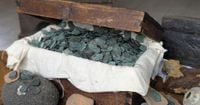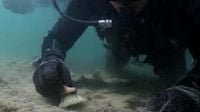Hidden beneath the rolling turquoise waves of Florida’s Atlantic coastline, history has resurfaced in a truly dazzling fashion. This summer, a team of divers working for 1715 Fleet – Queens Jewels LLC, a licensed shipwreck salvage company, uncovered more than 1,000 gold and silver coins off the aptly named “Treasure Coast.” According to the Associated Press, the coins are estimated to be worth around $1 million and are believed to date back over 300 years, making this one of the most significant finds in recent years.
The story behind this glittering haul is as dramatic as any pirate tale. On July 31, 1715, a powerful hurricane struck a fleet of 11 Spanish galleons sailing from the New World back to Spain. Laden with gold, silver, and jewels mined from the Spanish colonies of Bolivia, Mexico, and Peru, the fleet was caught off guard by the storm and wrecked between what is now Melbourne and Fort Pierce, Florida. The disaster scattered the ships’ treasures across the ocean floor, creating a legend that has lured treasure hunters for centuries and given the region its evocative nickname.
1715 Fleet – Queens Jewels LLC, which holds a license to search this historic stretch of coastline, announced the discovery this past week. The company’s operations director, Sal Guttuso, described the magnitude of the find with palpable excitement. “This discovery is not only about the treasure itself, but the stories it tells,” Guttuso told the Associated Press. “Each coin is a piece of history, a tangible link to the people who lived, worked, and sailed during the Golden Age of the Spanish Empire. Finding 1,000 of them in a single recovery is both rare and extraordinary.”
Recovering these centuries-old coins was no easy feat. The divers employed a mix of modern technology and old-fashioned grit, using metal detectors, underwater scanning tools, and manual sand-fanning techniques to locate and extract the coins from the sandy seabed. According to reports from both the Associated Press and the 1715 Fleet Society, many of the coins still bear visible dates and mint marks—a detail that excites both historians and collectors. These markings can provide vital clues about the coins’ origins and the broader story of the Spanish Empire’s colonial ambitions in the Americas.
The Treasure Coast has long been a magnet for fortune seekers and historians alike. Over the centuries, millions of dollars’ worth of coins and artifacts from the 1715 fleet have been recovered from the area. Yet, as this summer’s discovery shows, the sea continues to guard its secrets, occasionally offering up fresh glimpses into a lost world. For those involved in the hunt, the thrill isn’t just about the monetary value. It’s about the connection to a dramatic chapter in global history—a time when empires rose and fell on the back of such treasures.
Florida’s laws regarding these finds are clear and designed to balance the interests of the state, the public, and the salvage companies. Any historic artifacts found in state waters legally belong to the state itself. Roughly 20% of all recovered items are kept for research or for display in public museums, ensuring that the broader public can share in the wonder of these discoveries. The rest of the artifacts are divided between the salvage company and its subcontractors, but only after a detailed inventory is reviewed and approved by state officials and the courts. “We want to do it right,” Guttuso told the Associated Press. “And it benefits the people of Florida—these treasures end up in museums for everyone to enjoy.”
The process is not without its risks and complications. Just last year, Florida officials recovered dozens of gold coins that had been stolen from the wreck site. The suspect, it turned out, was a family member of a subcontractor working with 1715 Fleet – Queens Jewels LLC. The episode served as a stark reminder of the temptations and challenges that come with treasure hunting, even in the modern era. It also underscored the importance of strict oversight and legal compliance in the management of such valuable and culturally significant finds.
While the allure of sunken treasure is undeniable, the backdrop to this summer’s discovery is a coastline shaped by both fortune and tragedy. The hurricane that doomed the Spanish fleet in 1715 was just one of many powerful storms to batter the region over the centuries. According to the National Oceanic and Atmospheric Administration (NOAA), hurricanes have caused more than $1.3 trillion in damages in the United States since 1980, and the 2024 season alone saw damages soar to over $1.5 trillion. The Treasure Coast’s very name is a testament to the dual forces of nature and history—where devastating storms have both destroyed and revealed, scattering riches and stories alike across the ocean floor.
As the 2025 hurricane season gets underway, experts predict slightly fewer major storms than in previous years, but with 19 storms expected, including nine that could become hurricanes, the region remains ever-vigilant. The same natural forces that once spelled disaster for the Spanish fleet still shape life on Florida’s coast today. Advances in technology and forecasting have made hurricanes less deadly than in the past, but the risk—and the connection to history—remains ever-present.
For now, the newly recovered coins will undergo cataloging and conservation, their details scrutinized by experts and, eventually, shared with the public. Some will likely find their way into museum displays, offering visitors a tangible link to the drama of the high seas and the global currents of commerce, conquest, and catastrophe that defined the early 18th century. For the divers and historians involved, the real treasure may be the stories these coins can tell—about the people who minted them, the sailors who carried them, and the storms that changed the course of history.
In a world that often feels disconnected from the past, discoveries like this serve as a vivid reminder that history is always just beneath the surface—sometimes, quite literally. The Treasure Coast has lived up to its name once again, proving that even after three centuries, the sea still has secrets left to share.





